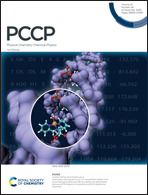Spectroscopic evidence of n → π* interactions involving carbonyl groups†
Abstract
n → π* has emerged as an important noncovalent interaction that can affect the conformations of both small- and macromolecules including peptides and proteins. Carbonyl–carbonyl (CO⋯CO) n → π* interactions involving CO groups are well studied. Recent studies have shown that the CO⋯CO n → π* interactions are the most abundant secondary interactions in proteins with a frequency of 33 interactions per 100 residues and, among the various secondary interactions, n → π* interactions are expected to provide the highest enthalpic contributions to the conformational stability of globular proteins. However, n → π* interactions are relatively weak and provide an average stabilization of about 0.25 kcal mol−1 per interaction in proteins. The strongest n → π* interaction could be as strong as a moderate hydrogen bond. Therefore, it is challenging to detect and quantify these weak interactions, especially in solution in the presence of perturbation from other intermolecular interactions. Accordingly, spectroscopic investigations that can provide direct evidence of n → π* interaction are limited, and the majority of papers published in this area have relied on X-ray crystallography and/or theoretical calculations to establish the presence of this interaction. The aim of this perspective is to discuss the studies where a spectroscopic signature in support of n → π* interaction was observed. As the “n → π* interaction” is a relatively new terminology, there remains the possibility of there being earlier studies where spectroscopic evidence for n → π* interactions was obtained but it was not discussed in light of the n → π* terminology. We noticed several such studies and, as can be expected, these studies were often overlooked in the discussion of n → π* interactions in the recent literature. In this perspective, we have also discussed these studies and provided computational support for the presence of n → π* interaction.

- This article is part of the themed collection: PCCP Perspectives


 Please wait while we load your content...
Please wait while we load your content...